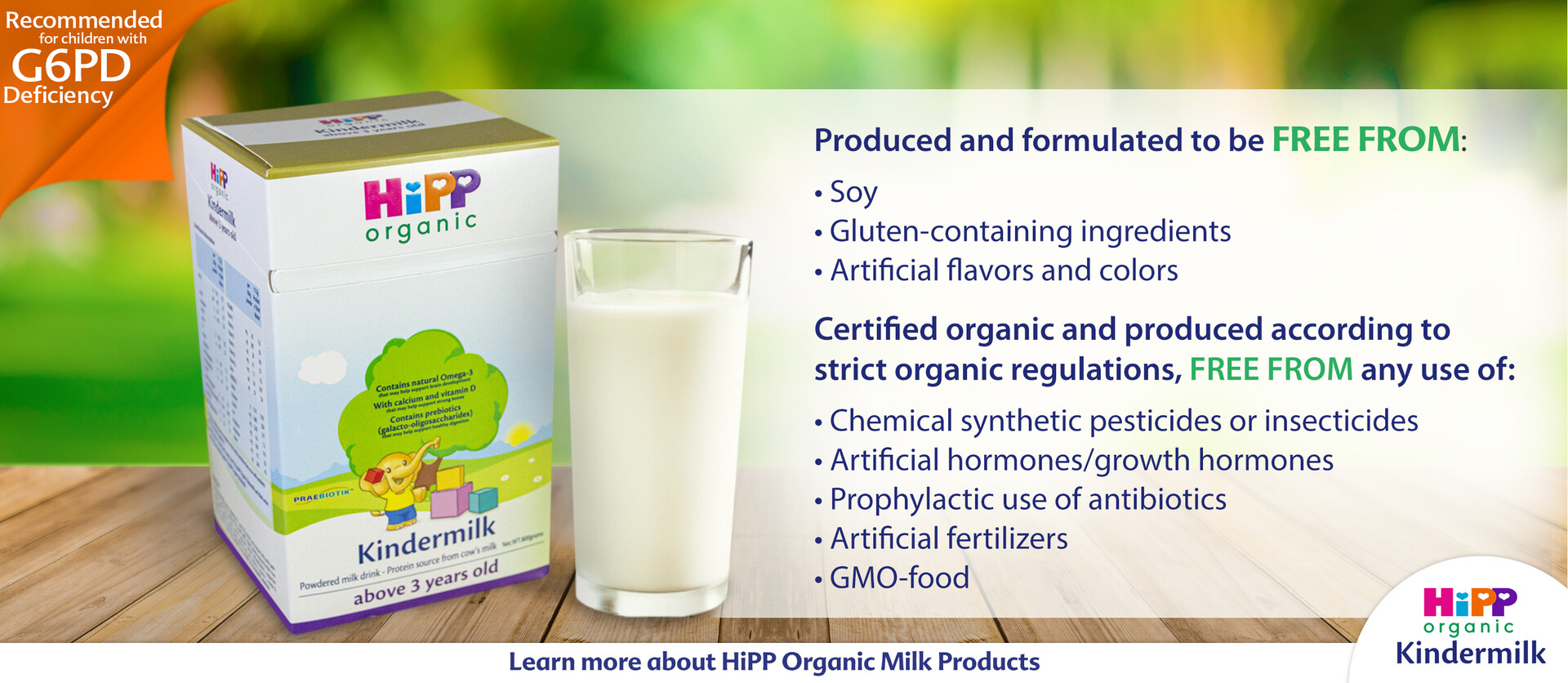Choosing the right milk for children with g6pd deficiency
Milk is an essential part of a young child’s daily diet. It contains vital nutrients that help with their growth and development. However, if your child has G6PD deficiency, choosing a suitable milk product can be challenging.
Children with G6PD deficiency must avoid products like soy, but this ingredient often appears in various forms in many milks. This article provides important information to help you identify the right milk for your child.
MEDICAL DISCLAIMER: The information included in this material is for informational purposes only. Always seek medical advice for any concerns about health and nutrition.
G6PD Deficiency: What is it?
G6PD deficiency is a genetic condition that affects red blood cells that carry oxygen to all parts of the body. Exposure to specific triggers may cause these cells to break down and cause anemia.
While G6PD is a genetic condition, not everyone with G6PD deficiency is affected in the same way. Some people may be affected mildly which can be managed, while others may have severe symptoms that require hospital care.
Symptoms of G6PD deficiency are the following:
- Pale skin
- Extreme tiredness
- Fast heartbeat
- Fast breathing or shortness of breath
- Yellow skin and eyes/Jaundice
- Dark urine
Common Triggers:
- Foods: Fava beans, soy products, red wines, legumes, or tonic water
- Chemicals: Naphthalene
- Antibiotics: Sulfonamides, Co-trimoxazole
- Other Medications: Aspirin, Large doses of Vitamin C
Food and medications to avoid with G6PD deficiency
People with G6PD deficiency should avoid foods, drugs, and substances that are known to trigger hemolysis, which is the destruction of red blood cells. Here are some common foods and substances to avoid:
- Fava Beans: Fava beans (also known as broad beans) are one of the most well-known triggers of hemolysis in individuals with G6PD deficiency. Consumption of fava beans can lead to severe reactions and should be strictly avoided.
- Legumes and Vegetables: Some, like chickpeas and certain types of beans, should be consumed in moderation due to their potential to trigger hemolysis.
- Medications: Certain medications can also trigger hemolysis. These include some antimalarial drugs, sulfonamides, and certain pain relievers like aspirin and ibuprofen. Always inform your healthcare provider about your G6PD deficiency to avoid medications that can be harmful.
- Vicia Species: Besides fava beans, other Vicia species like moth beans, black-eyed peas, and other legumes should be avoided or consumed in moderation, as they may contain triggers for hemolysis.
- Food Additives: Some food additives like sulfites (often used as preservatives) and artificial food coloring agents can potentially cause problems for individuals with G6PD deficiency. Reading food labels to avoid products with these additives is advisable.
- Vitamin K: Extremely high doses of vitamin K (often found in leafy greens and broccoli) can potentially be problematic, but normal dietary intake of vitamin K is usually safe.
- Naphthalene: Naphthalene is a chemical used in mothballs. Inhaling or ingesting products containing naphthalene can lead to hemolysis in individuals with G6PD deficiency.
The importance of soy-free milk
Soy or soybean is a type of legume widely used as a functional ingredient in many food products. Isolated protein from soybeans is a common food ingredient used in many milk because it is high in protein and easily digestible. The oil by-product of soybeans is also widely used as a source of linoleic acid.
Some by-products of soy are also used as emulsifiers in powdered milk drinks. Despite their good nutritional and functional qualities, milk products containing soy ingredients are unsuitable for children with G6PD deficiency.
According to the G6PD Deficiency Association, food items containing Soy and other legumes (e.g, Fava or broad beans) may cause damage to the red blood cells of children with G6PD deficiency. In addition, the National Institutes of Health-Philippines strongly recommends avoiding food and drinks with soy.
How to spot soy ingredients on food labels
Always check the entire food label of milk products and search for soy ingredients as they can be hidden in multiple names. Here is the list of ingredients that may indicate the presence of soy.
- Soybean oil
- Hydrolyzed soy protein
- Soy albumin
- Soy concentrate
- Textured soy protein
- Soy protein concentrate
- Soy protein isolate
- Soy lecithin
References
[1] Tripathi, M. and Shrivastava, R. (2017). Processing and Utilization of Soy Food By‐Products. pp.231–276. doi:https://doi.org/10.1002/9781118432921.ch11
[2] Ponder, D.L., Innis, S.M., Benson, J.D. and Siegman, J.S. (1992). Docosahexaenoic Acid Status of Term Infants Fed Breast Milk or Infant Formula Containing Soy Oil or Corn Oil. Pediatric Research, 32(6), pp.683–687. doi:https://doi.org/10.1203/00006450-199212000-00012
[3] Castejon, L.V., Almeida, E.S., Cardoso, V.S., dos Santos, K.G. and Finzer, J.R.D. (2017). Characteristics of the Milk Powder Particles Lecithinated. Materials Science Forum, 899, pp.167–172. doi:https://doi.org/10.4028/www.scientific.net/msf.899.167
[4] Stuhrman, G., Perez Juanazo, S.J., Crivelly, K., Smith, J., Andersson, H. and Morava, E. (2017). False-Positive Newborn Screen Using the Beutler Spot Assay for Galactosemia in Glucose-6-Phosphate Dehydrogenase Deficiency. JIMD Reports, [online] pp.1–5. doi:https://doi.org/10.1007/8904_2016_34
[5] National Institutes of Health-Philippines. (2017). Glucose-6-Phosphate Dehydrogenase Deficiency [Brochure].
[6] Kids With Food Allergies. (n.d.). Soy Allergy. [online] Available at: https://kidswithfoodallergies.org/living-with-food-allergies/top-food-allergens/soy-allergy/ Accessed 12 Oct. 2023
[7] Mayo Clinic. (2018). Allergies - Symptoms and causes. [online] Available at: https://www.mayoclinic.org/diseases-conditions/allergies/symptoms-causes/syc-20351497
Subscribe
If you wish to receive priority alert on related articles, you may provide us your information:
click here





